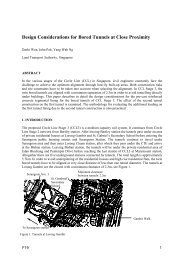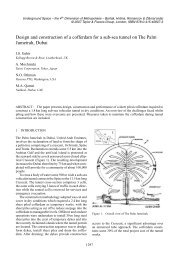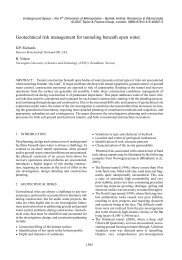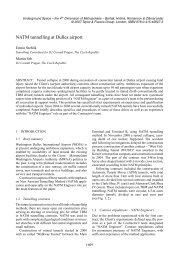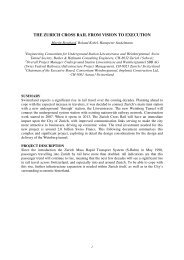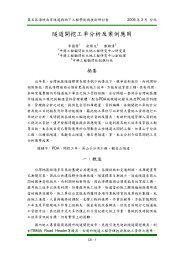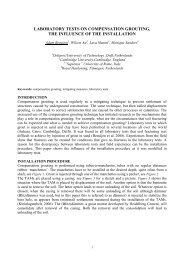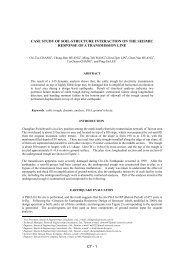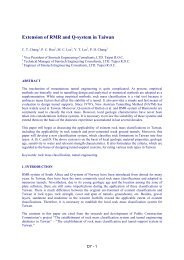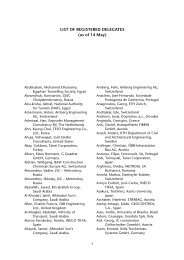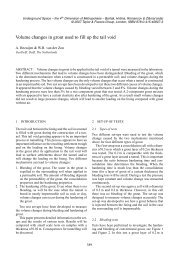Gotthard base tunnel rock burst phenomena in a fault zone ...
Gotthard base tunnel rock burst phenomena in a fault zone ...
Gotthard base tunnel rock burst phenomena in a fault zone ...
You also want an ePaper? Increase the reach of your titles
YUMPU automatically turns print PDFs into web optimized ePapers that Google loves.
Cross cavern<br />
East Tube EON<br />
West Tube EWN<br />
Figure 1 Schematic orig<strong>in</strong>al layout of the multifunction section at Faido.<br />
0 km<br />
57 km<br />
420<br />
MFS Faido<br />
Figure 2. Geology along the <strong>Gotthard</strong> Base Tunnel consist<strong>in</strong>g ma<strong>in</strong>ly of gneiss and granite.<br />
MFS Faido is located <strong>in</strong> the Levent<strong>in</strong>a Gneiss of very good quality<br />
1.3 Actual Geology <strong>in</strong> the area of the MFS Faido<br />
Dur<strong>in</strong>g construction of the cross cavern (Figure 1) a<br />
break down of f<strong>in</strong>e gra<strong>in</strong>ed quartz occurred <strong>in</strong> the<br />
cavern’s roof form<strong>in</strong>g a cavity of 8 meters <strong>in</strong> height.<br />
The results of an extensive drill holes campaign<br />
together with seismic reflection measurements<br />
effectuated dur<strong>in</strong>g construction revealed an<br />
unknown large <strong>fault</strong> system <strong>in</strong> the area of the MFS<br />
Faido. The ma<strong>in</strong> kernel of this <strong>fault</strong> strikes at an<br />
average angle of about 15° to the <strong>tunnel</strong> axis and<br />
dips at about 80°. The <strong>fault</strong> system encountered<br />
dur<strong>in</strong>g construction is shown <strong>in</strong> Figure 3. In the<br />
<strong>fault</strong>’s kernel, layers of partially completely<br />
decomposed <strong>rock</strong> (kakitrite) are embedded.<br />
Adjacent to the east of the <strong>fault</strong> hard and brittle<br />
Levent<strong>in</strong>a gneiss is located. To the west of the <strong>fault</strong><br />
the <strong>rock</strong> mass consists of hard but less brittle<br />
Lucomagno gneiss.<br />
2. DIFFICULTIES DURING CONSTRUCTION<br />
Dur<strong>in</strong>g the first rebuild<strong>in</strong>g of the EWN tube to the<br />
north of the cross cavern (Figure 1) a support<br />
consist<strong>in</strong>g of steel arches HEM 200 backfilled with<br />
40 cm concrete was <strong>in</strong>stalled immediately after each<br />
excavation step of 1 m. This rigid support was<br />
<strong>in</strong>tended to cater for the heavy pressure and<br />
especially to protect workforce from break outs at<br />
the face. In the rebuilt section, on a length of 250 m<br />
(Figure 3) the load<strong>in</strong>g of the support however gave<br />
rise to radial displacements of up to 1 m. Stra<strong>in</strong>



